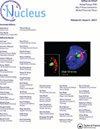染色质拓扑结构和基因表达的机械决定因素
IF 4.5
3区 生物学
Q3 CELL BIOLOGY
引用次数: 14
摘要
将线性DNA压实成微米大小的核边界涉及建立特定的三维(3D) DNA结构与形成染色质的组蛋白复合物。由此产生的结构调节基本的核过程,如转录、复制和修复,以促进或阻碍它们的多步骤进展,这些有助于3d基因组组织的动态修饰。人们普遍认为蛋白质-蛋白质和蛋白质- dna相互作用构成了3d基因组组织的基础。然而,由沿着DNA易位的各种蛋白质产生的机械力、扭矩和其他压力的不断产生,可能在基因组组织中发挥着比目前所认识到的更大的作用。显然,对DNA交易对基因组三维组织施加的机械决定因素的透彻理解是必需的。我们在这里概述了我们目前的知识,并强调DNA和染色质力学在基因表达中的重要性。本文章由计算机程序翻译,如有差异,请以英文原文为准。
Mechanical determinants of chromatin topology and gene expression
ABSTRACT The compaction of linear DNA into micrometer-sized nuclear boundaries involves the establishment of specific three-dimensional (3D) DNA structures complexed with histone proteins that form chromatin. The resulting structures modulate essential nuclear processes such as transcription, replication, and repair to facilitate or impede their multi-step progression and these contribute to dynamic modification of the 3D-genome organization. It is generally accepted that protein–protein and protein–DNA interactions form the basis of 3D-genome organization. However, the constant generation of mechanical forces, torques, and other stresses produced by various proteins translocating along DNA could be playing a larger role in genome organization than currently appreciated. Clearly, a thorough understanding of the mechanical determinants imposed by DNA transactions on the 3D organization of the genome is required. We provide here an overview of our current knowledge and highlight the importance of DNA and chromatin mechanics in gene expression.
求助全文
通过发布文献求助,成功后即可免费获取论文全文。
去求助
来源期刊

Nucleus
CELL BIOLOGY-
CiteScore
5.60
自引率
5.40%
发文量
16
审稿时长
13 weeks
期刊介绍:
Nucleus is a fully open access peer-reviewed journal. All articles will (if accepted) be available for anyone to read anywhere, at any time immediately on publication.
Aims & Scope: The eukaryotic cell nucleus is more than a storage organelle for genomic DNA. It is involved in critical steps of cell signaling and gene regulation, as well as the maintenance of genome stability, including DNA replication and DNA damage repair. These activities heavily depend on the spatial and temporal “functional” organization of the nucleus and its integration into the complex meshwork of cellular scaffolding.
Nucleus provides a platform for presenting and discussing cutting-edge research on all aspects of biology of the cell nucleus. It brings together a multidisciplinary community of scientists working in the areas of:
• Nuclear structure and dynamics
• Subnuclear organelles
• Chromatin organization
• Nuclear transport
• DNA replication and DNA damage repair
• Gene expression and RNA processing
• Nucleus in signaling and development
Nucleus offers a variety of paper formats including:
• Original Research articles
• Short Reports
• Reviews
• Commentaries
• Extra Views
• Methods manuscripts.
 求助内容:
求助内容: 应助结果提醒方式:
应助结果提醒方式:


